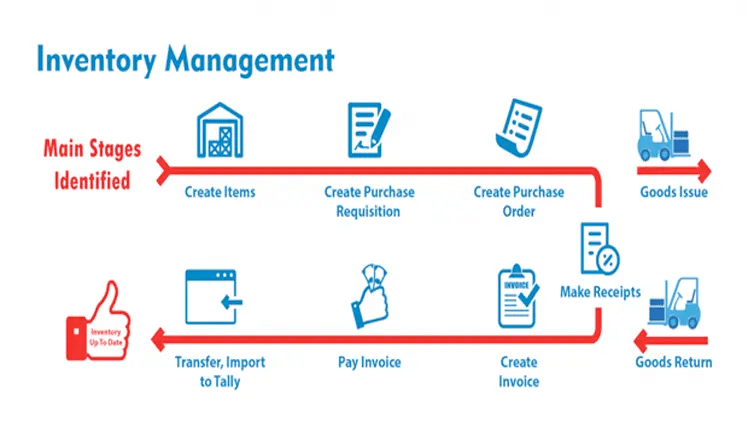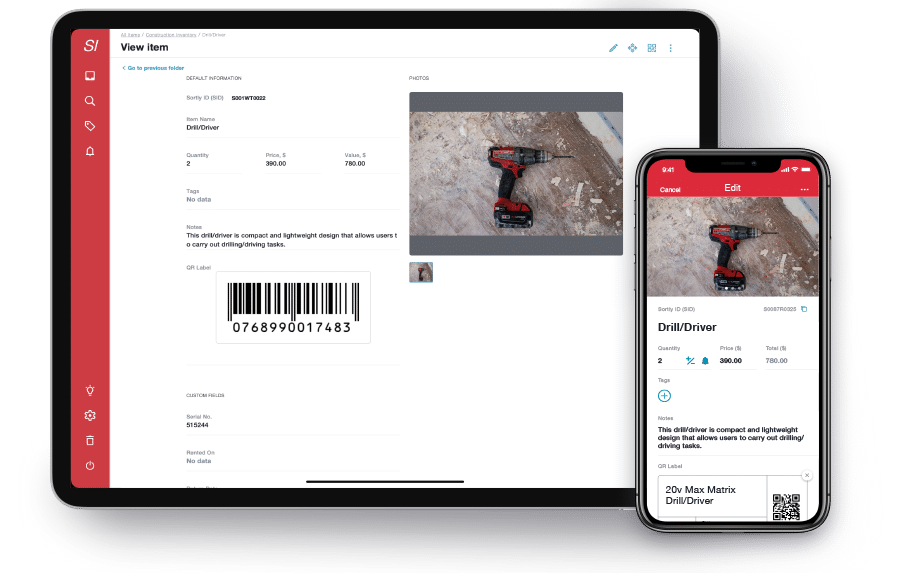Inventory tracking is critical to effective stock management, ensuring businesses have the right amount of products at the right time. It involves using technology to monitor inventory levels, track product movement, and update stock data in real time. Accurate inventory tracking helps businesses optimize operations, reduce costs, and improve customer satisfaction by preventing stockouts and overstocking. In today’s competitive retail environment, efficient inventory tracking is essential for staying ahead.
Yet a lot of smaller firms and business owners still neglect inventory control, and this can cause major problems. For instance, employee theft and administrative errors will be harder to track. This leads to inventory shrinkage, which according to a study cost US retailers $61.7bn in 2020.

Source: Medium
Understanding Inventory Tracking
Inventory tracking monitors the movement, quantity, and status of goods within a business. This involves maintaining accurate records of stock levels, product movements, and sales transactions throughout the entire supply chain. Effective inventory tracking ensures firms know exactly what products are in stock, what’s on order, and what needs replenishment, helping prevent stockouts and overstocking.
Inventory tracking software gives businesses real-time visibility into their stock levels, enabling them to make better decisions. The result is more efficient operations, cost savings, and improved customer satisfaction. For businesses of all sizes, inventory tracking is essential for optimizing supply chain processes and maintaining a healthy flow of goods from suppliers to customers. It’s particularly important for forecasting demand, as accurate tracking enables businesses to predict future stock needs and adjust accordingly.
As companies grow, inventory management becomes more complex, so having a robust and scalable inventory tracking system becomes crucial. Proper tracking allows businesses to stay organized, responsive to market demands, and competitive in an increasingly fast-paced retail environment.
Finally, we’ll conclude by outlining some of the best ways to keep track of inventory, including recommended inventory planning software.
Manual vs. automated tracking
If you’re a small business that’s just getting started in retail, and you don’t stock too many SKUs, you might choose to use manual methods to keep track of your stock.
On the face of it, tracking inventory with spreadsheets (or even pen and paper) is a low-cost practice. But unless you’re super-organized, manual inventory tracking is prone to errors that can actually end up costing you money.
For example, if you accidentally write an extra zero on your order, you’ll end up with excess stock—and if you forget to re-order in time for the holidays, you’ll have a stockout.
That’s why automated inventory tracking is a better solution. It’s far more accurate, giving you real-time visibility of inventory across multiple locations. It’ll sync the data each time stock levels change, and even generate reports for you.
The benefits of tracking inventory
Adopting an effective inventory management system has numerous potential advantages. For example, according to a survey conducted by business communications organisation GS1 (which first developed the barcode), using inventory tracker tech, such as radio frequency identification (RFID), can increase inventory accuracy to as much as 95 per cent.
With accurate inventory management and tracking, businesses can reap real rewards. Firms which know exactly how many products they have in stock and how many on order can save time as well as money. It saves them from having to go to the trouble of carrying out inventory recounts, thus freeing up staff to do more important and productive things. It also helps to prevent stockouts, which inconvenience customers.
By the same token, inventory tracking can also help to improve overall efficiency and productivity standards. Technology such as barcode scanners, QR codes, and even mobile apps can eliminate a lot of the more menial manual processes, so that members of your team can devote their energies elsewhere. This can also enable you to improve your workflow, customer service standards, and the general customer experience.
Indeed, the customer experience is hugely important, and it must not be overlooked here. Consumers who know they can rely on your business to provide them with the kinds of products they want, when they want them, are much more likely to keep coming back again and again. This is an effective way of fostering lasting, long-term customer and brand loyalty.
As well as all this, reliable and accurate inventory tracking can also ensure that warehouses are generally better organized. This is part of a virtuous circle: the better your inventory management, the more organized your warehouse will be, which in turn helps to improve inventory management even further.
For wholesalers and retailers alike, this can be hugely beneficial. The ultimate beneficiaries, of course, are consumers: good inventory management means that orders can be dispatched in a timely manner, which again leads to better customer experiences.
Case studies back these hypotheses up, too. For instance, global fashion retail chain H&M (which has a complex supply chain incorporating some 30 partners worldwide) found that introducing a centralized inventory management system helped to cut average lead times by between 15 and 20 per cent. Lower lead times reduce the risk of buying the wrong items.
Just-in-time inventory management is one technique which has been widely adopted in the retail sector. It’s designed to minimize waste and reduce costs by ensuring that goods are received as and when they’re needed and most in demand by consumers.
With just-in-time management, firms can improve cash flow (as less storage space is needed), reduce excess stock, and cut inventory holding costs. However, there are risks involved, too. Firms which adopt just-in-time methods must make sure they have accurate demand forecasts and a thorough understanding of customers’ purchasing habits.
- Improved accuracy and data integrity: Using real-time tracking reduces human errors common in manual inventory management. Automatic updates ensure that inventory levels are always current, and businesses can rely on this data for more accurate stock counts, preventing costly mistakes.
- Better forecasting and decision-making: By leveraging real-time data, businesses can make more informed decisions about stock replenishment, supplier orders, and sales strategies. This helps prevent stockouts or overstocking, contributing to a more efficient inventory flow.
- Cost reduction: Tracking inventory accurately helps avoid excessive stock accumulation, leading to better cash flow management. It prevents tying up capital in slow-moving goods and minimizes storage costs. It also helps reduce waste by identifying products that are not selling well before they expire or become obsolete.
- Enhanced customer satisfaction and loyalty: An accurate inventory system ensures that products are available when customers need them, which leads to faster order fulfillment and reduced lead times. Consistently having products in stock increases customer trust and encourages repeat business.
Real-time visibility and control: Businesses gain visibility into stock levels across various locations in real time. Whether you operate from multiple warehouses, retail stores, or e-commerce channels, tracking systems provide centralized oversight, making managing inventory in dynamic, fast-paced environments easier.
Challenges in inventory tracking
While the benefits of inventory tracking speak for themselves, it’s important to be aware of the challenges involved as well. A solid understanding of these challenges is vital, as it can help businesses avoid falling victim to them.
- Time-consuming manual tracking methods: Despite the availability of software tools, some businesses still rely on paper-based or spreadsheet systems, which can be highly inefficient and prone to errors. Manual data entry into systems often leads to inaccuracies and increases the time spent on stocktaking tasks.
- Difficulty managing inventory across multiple locations: As businesses grow and expand across different locations, keeping track of stock across warehouses, retail outlets, or distribution centers becomes more complex. Maintaining accurate inventory records in different geographic areas is harder, leading to inefficiencies and errors.
- Inventory shrinkage due to theft, damage, or misplacement: Without accurate tracking, businesses may not notice when products are lost or stolen. Shrinkage can also occur due to damaged goods not adequately accounted for, affecting overall inventory levels and profitability.
- The risk of stockouts and overstocking: Without a streamlined tracking system, businesses risk running out of in-demand products or overstocking items that aren’t selling well. Both scenarios lead to missed sales opportunities and increased operational costs.
- Delayed access to real-time data: Older methods like spreadsheets or paper logs often make inventory data inaccurate or delayed. This lack of real-time updates hinders decision-making, as businesses are forced to rely on outdated or incomplete information when managing stock levels.
- Integration challenges with existing software systems: Inventory tracking software needs to seamlessly integrate with other business systems such as accounting, sales, or order management. If these systems aren’t well-integrated, data discrepancies can occur, creating inefficiencies and confusion across departments.
- Managing large or complex inventories: As businesses scale, managing larger inventories becomes increasingly tricky. This is particularly true for businesses with extensive product lines or a high number of SKUs. The more items you track, the more difficult it is to keep accurate records, leading to a higher risk of inventory management errors.
Bigger inventories are harder to manage
We’ve already alluded to this point, but bigger inventories are more complicated to manage. Obviously, ambitious entrepreneurs will always be looking for opportunities to grow. But as sales increase, so will inventory turnover, and managing this is undeniably tricky.
You might find yourself carrying multiple varieties of the same product type, so the task here is keeping track of all of these – in all their respective sizes, colors, styles and so on. As well as managing their pricing, while ensuring that your business has enough of each to meet customer demand. Scaling up inventory tracking is therefore one of the toughest hurdles for growing businesses to overcome.

How to keep track of inventory efficiently
There are various methods of tracking inventory, some of which are more effective than others. Let’s take a look at some of them here.
Common methods: Pen and paper vs. Excel and Google Sheets
Some businesses (usually long-established smaller firms) still use manual pen-and-paper methods, writing down the details of each transaction on a card system. However, this is clearly a less than optimal way of doing it, and the majority of businesses have long since moved on from such methods.
Excel spreadsheets
Some businesses simply use Excel spreadsheets to keep track of inventory. This is okay for small companies dealing with very low order volumes, but it is likely to prove inadequate even for medium-sized businesses. As your business grows, you’ll probably soon find that these spreadsheets aren’t up to the task.
There are a number of problems with using spreadsheets to track inventory. As we’ve just observed, tracking large quantities this way is very difficult. Human error in record-keeping is all too common. Businesses also lack real-time data, which again makes it much harder to keep an accurate record of inventory. Forecasting is also made more difficult as there is less historical data at hand.
Tracking inventory with Google Sheets
Although spreadsheets are a step up from paper copies, you still have to enter information manually. But if you use Google Sheets, there’s a way to automatically update your inventory every time it changes. You can set this up using Zapier, which connects your apps and moves information between them based on your own rules.
Basically, you can set a “trigger” action that tells the spreadsheet to update itself. In this case the trigger would be a new response in Google Forms. Once you create a new Form from within your Sheet and add the fields you’d want to update, a new tab is automatically created so that every time you fill out the Form, your responses will be routed there.
Click here for full instructions on how to track inventory in Google Sheets.
Third-party logistics: Streamlining inventory tracking
Another option is to outsource order fulfillment to a third-party logistics firm and thus let it take care of the whole process. As these firms handle your orders, they also have responsibility for your inventory, packing, and shipping orders to customers. They can also provide detailed, real-time inventory reports, and keep tabs on exact inventory levels.
Mobile apps
Increasingly, many businesses (including many startups) are using iOS and Android apps instead of spreadsheets. Apps such as Sortly, Stock Control, and Goods Order Inventory are widely used among small firms. However, businesses can often find these apps somewhat limiting as they expand and their needs grow more complex.
Source: Sortly
Inventory tracking software
Inventory tracking software provides a much more comprehensive overview of inventory. Warehouse operatives can scan 2D barcode labels as orders are processed, providing an instant record of which items are in stock, which items are running low, and which are overstocked. This is just one of the ways in which automation is making life easier for businesses and their workers alike.
Other advantages of inventory tracking software include quicker auditing, enhanced mobility, cycle counts, and more accurate reporting. Compared to the pen-and-paper or spreadsheet method, this opens up far greater possibilities for businesses and provides them with a much more detailed understanding of their inventories.
An advanced inventory tracking system, by having more data and allowing for in-depth analysis, can also allow for data-driven inventory planning. Excess stock and overselling are part of the most common problems; businesses need to anticipate demand to maximize sales without having too much cash tied up in slow moving products.
Inventory management software with inventory demand planning functionality can help to prevent this, with detailed historical data helping businesses to better understand fluctuations in customer buying patterns. Businesses are given a clearer idea of what they need to reorder at specific points in the business cycle.

Integrating inventory tracking with supply chain management
Effective inventory tracking is essential to good supply chain management. Inventory management is one vital aspect of supply chain management, and there are different elements to tracking inventory. It’s not just a matter of keeping an eye on how many products you have in a particular place at a particular time.
You also need to track inventory from suppliers, to track customer returns (because these are inevitable) and to monitor damaged goods (ditto). If your inventory management methods fall short in any one of these areas, it’ll be your customers who will likely suffer – in the form of delayed deliveries and incorrect or incomplete orders.
To ensure efficient supply chain management, you must ensure that your understanding of your customers’ wishes and your forecasting methods are up to par. In other words, being able to anticipate what consumers will want, and when they’ll want it. Seasonality is a crucial consideration in this regard. We all know about the Christmas rush, but this isn’t the only seasonal fluctuation you should be braced for.
You should also be careful to make sure that your supply chain partners are a good fit. Maintaining good supply chain relationships is indispensable to keeping your business ticking over. And, most importantly of all, making for a better all-round customer experience. Make sure you carry out thorough research before choosing partners.

What is the best way to keep track of inventory?
Following on from our previous point, choosing the right inventory management solution is also of crucial importance. Inventory planning software is built-in into the wider retail operating system and enabled you to ensure you have enough inventory in the right places in order to provide your customers with what they need at all times.
It provides comprehensive functionality and a centralized overview of your operations, allowing you to manage inventory, orders, purchasing, accounting, point of sale, suppliers and more – across multiple channels and locations.
With Brightpearl, you can also get real-time insight into sales performance, costs, and profitability, as well as undertaking smart planning based on previous data. It also makes it easy to automate repeat inventory control tasks and set customized rules so that goods are automatically routed to a warehouse, or replenished when they’re running low.
Keeping your customers happy is a challenge at the best of times, and it’s only growing even more challenging. With the right inventory management software, you can enjoy a whole heap of benefits – better productivity, greater efficiency, clearer visibility – and your customers, without even realizing it, will be the ones who really benefit.
Frequently Asked Questions:
- What is the best inventory tracking system?
The best inventory tracking system depends on your business’s specific needs, but top choices include Brightpearl, TradeGecko, and NetSuite. These systems offer real-time inventory updates, integrate with other business functions like accounting and sales, and provide scalability for growing businesses. Look for features like multi-location support, barcode scanning, and mobile access to streamline tracking processes and reduce human error.
- What is the difference between inventory management and inventory tracking?
Inventory management is the broader process of overseeing and controlling stock levels, orders, and storage across your supply chain. It includes tasks like reordering, stock forecasting, and managing suppliers.
On the other hand, inventory tracking refers explicitly to monitoring the movement of inventory items in real time. It ensures accurate record-keeping of the quantity and location of each item in the system. Tracking is a key component of effective inventory management, providing visibility and preventing stockouts or excess inventory.
- How to track inventory without software?
Tracking inventory without software is possible, but more prone to human error. Here are methods businesses use:
-
- Manual logbooks: Record each item and its details in a physical ledger.
-
- Spreadsheets: Use Excel or Google Sheets to track stock, updates, and sales.
-
- Barcode or QR codes: Manually scan items and update inventory records.
-
- Physical stocktaking: Conduct regular stock counts and compare with records.
These methods can be time-consuming and inefficient, especially as the business grows, which is why software solutions become necessary.
- What is the best method to count inventory?
The best method for counting inventory depends on the size and complexity of your business. Common methods include:
-
- Periodic inventory system: Perform counts at specific intervals (e.g., monthly or quarterly).
- Perpetual inventory system: Track inventory in real time using software and automated updates for each transaction.
- Cycle counting: Regularly count portions of inventory, rather than performing a full count, to ensure continuous accuracy without disrupting business operations.
Combining automated systems with periodic physical counts can provide the most reliable results for accurate inventory control



